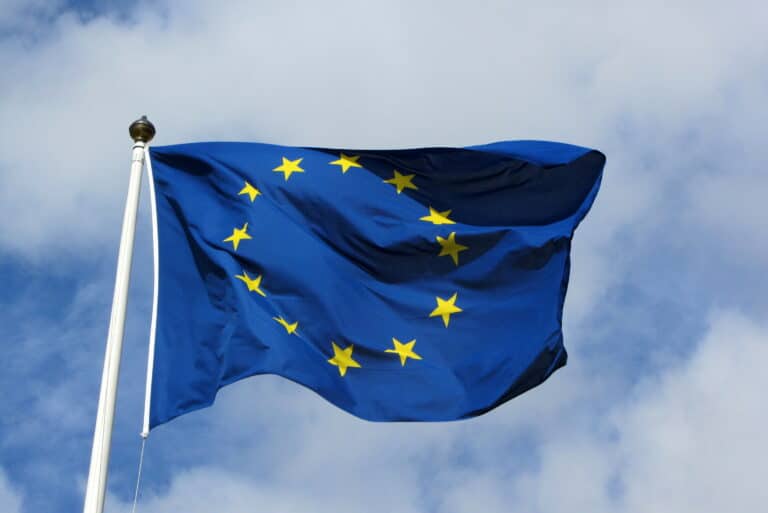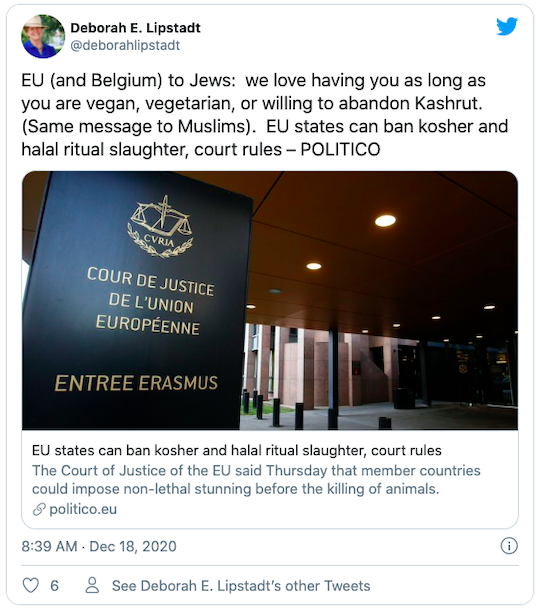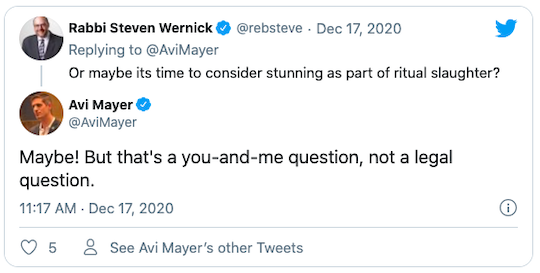
This Weekly is dedicated to Dr. Aviva Weisbord z’l, a courageous Jewish leader from a dynastic Jewish family. Dr. Weisbord passed away this past Shabbat. Though she lost her battle with COVID-19, she wrote an article a few months ago reminding us all of one of the silver linings of the coronavirus, saying, “We’ve pulled out of the rat race, becoming human beings instead of human doings.”
Though Dr. Weisbord is no longer among the living, let’s all internalize the life lessons she left us.
For today’s controversial topic, I thought it would be best for my colleague, Avi Posen to introduce it. You’ll see why. Enjoy Avi’s introduction to the story Sara Himeles unpacks for us all.
Best,
Noam
It was always a bit weird growing up as both a passionate vegetarian and the grandson of a shochet (a person who performs Jewish ritual slaughter). It was always puzzling to me how my Zaida, a Holocaust survivor from Poland and the most gentle person I know, was able to be a shochet for so many years.
I still remember hearing my Zaida’s story from his first visit to the slaughterhouse. He told me he was so traumatized from the experience that he couldn’t sleep for weeks. But, as with everything, my Zaida got used to it and ended up providing my hometown of Winnipeg, Canada with kosher meat for over twenty years. This is something that — despite my vegetarianism — I have always been proud of and admired.
With the recent news coming out of Europe of a new ban on shechita, it got me thinking. What kind of impact does this decision have on Jewish and Muslim life in Europe? Is this an issue of animal rights, or is it an issue of age-old hatred and prejudice? Who gets to determine what is moral and what is not?
This week we take a deep dive into this juicy topic (pun not intended…remember, I’m a vegetarian) and ask all the hard-hitting questions. Let’s get to it.
Avi
We’re Curious…
The European Union’s highest court recently ruled that member countries may ban the practice of ritual slaughter — which is required for the production of kosher and halal meat — in order to promote animal welfare. The decision from the Court of Justice of the EU upheld current laws in Belgium which ban the killing of animals without first stunning them.
Both Jewish and Muslim ritual slaughter (known as shechita in Hebrew and zabiha in Arabic, respectively) are aimed at minimizing animal suffering. They require animals’ throats to be slit with a sharp knife while they are conscious and uninjured. When carried out properly, experts say these methods are almost painless and lead to the animal’s rapid death.
However, supporters of stunning animals prior to slaughter argue that this method is more humane and effective in reducing animal suffering. An overwhelming majority of Jewish authorities agree that stunning violates the laws of shechita.
In addition to Belgium, Sweden, Norway, Iceland, Denmark and Slovenia also have laws prohibiting ritual slaughter by requiring prior stunning. The recent EU court ruling both confirms existing European bans against ritual slaughter and clears the way for additional member countries to impose similar laws.
Is stunning animals before slaughter really more humane, as its supporters claim? And was the EU court’s decision motivated by a desire to promote animal welfare, or is this a case of antisemitic and anti-Islam sentiment under the guise of humanist concerns?
Is Stunning Animals Before Slaughter Really More Humane?
Shechita is widely understood by rabbinic authorities as an expression of the commandment of tza’ar ba’alei chayim, preventing unnecessary cruelty to animals.
The legendary commentator Rambam (Maimonides) wrote in “The Guide for the Perplexed”: “The Torah commands that the death of the animal should be the easiest. It is not allowed to torment the animal by cutting the throat in a clumsy manner, by piercing it, or by cutting off a limb while the animal is still alive.”
In shechita, an extremely sharp knife is used to slit the animal’s throat, rendering it unconscious almost immediately. Some animal rights activists believe this method causes the animal to feel unnecessary pain and that stunning — a practice that is commonplace in the global industry — is the best way to reduce animal suffering.
However, others argue that the Jewish and Muslim methods are at least as humane as stunning. Research by Dr. Temple Grandin, one of the world’s leading experts on the humane treatment of animals for slaughter, supports this view. Defendants of ritual slaughter further argue that stunning itself can cause unnecessary pain since the animal is paralyzed and unable to show outward signs of suffering.
According to reporting by The New York Times, research on which method is more humane is inconsistent, with studies backing both sides of the issue. Some argue that studies showing that ritual slaughter is relatively less humane are agenda-driven and scientifically flawed.
“Evaluation of religious slaughter is an area where many people have lost scientific objectivity,” Grandin wrote. “This has resulted in biased and selective reviewing of the literature.”
Kosher Slaughter Bans and Antisemitism in European History
Jewish and Muslim leaders who question the motivations behind the recent EU court decision have good reasons to do so. In Belgium, the effort to ban ritual slaughter was led by right-wing nationalists and animal rights activists. Ben Weyts, a right-wing nationalist who is also a Belgian government minister in charge of animal welfare, first proposed the idea for the ban.
Historical precedents for kosher slaughter bans also raise alarm. Nazi Germany outlawed kosher slaughter in 1933, citing cruelty to animals. The law — one of the first acts of the Nazi regime — was meant to make Germany unlivable for Jews. In official propaganda, the Nazis deliberately misrepresented shechita as a Jewish celebration of animal suffering.
According to Marc Shapiro, a professor of Judaic Studies at the University of Scranton, commentators at the time described the Nazis’ anti-shechita decree by quoting Hosea 13:2: “Those who sacrifice men kiss calves.”
In his book, “Between the Yeshiva World and Modern Orthodoxy: The Life and Works of Rabbi Jehiel Jacob Weinberg, 1884-1966,” Shapiro tells the fascinating story of how Weinberg — an Orthodox rabbi living in Berlin at the start of the Nazi regime — attempted to find reasons to permit pre-slaughter stunning given the extreme circumstances.
Despite conventional wisdom that stunning violates shechita by injuring the animal and rendering it unconscious, Weinberg believed that using modern methods of stunning, there was a way to permit this practice within the bounds of Jewish law. He presented his case in a lengthy responsum, hoping that Jewish legal experts would support a leniency and prevent thousands of German Jews from consuming non-kosher meat.
However, Weinberg received a unanimously negative reply from the leading European rabbis of the time. After the war, Weinberg claimed that his rabbinic colleagues were unable to refute his view on halakhic grounds, but were still unwilling to permit stunning.
In addition to being opposed to changing shechita in general, European rabbis feared that altering the method of kosher slaughter would only bolster antisemitic claims that it was inhumane. They also felt that by making this move, they would be caving into the demands of antisemites who were determined to destroy Jewish religious life. Lacking support for his view, Weinberg ended his campaign to permit stunning.
Kashrut (Jewish dietary laws) have long been a focus of antisemitic campaigns in Europe. From the 13th through 19th centuries, “Judensau” sculptures — which mocked the prohibition against eating pork by showing Jews engaging in sexual activity with pigs — were popular in Germany and other European countries.
Given the long and painful history of antisemitism in Europe, as well as a more recent spread of animosity toward Muslims, it’s not surprising that many Jews and Muslims believe darker intentions are behind efforts to outlaw their practices. In addition to ritual slaughter, circumcision and dress are other areas of Jewish and Muslim religious life facing legal challenges in Europe.
The Jewish World Reacts to the EU Decision
Many Jewish leaders condemned the EU court decision as discriminatory against Jews and Muslims.
Avi Mayer, managing director of global communications for the American Jewish Committee, noted that the stunning requirement did not apply to hunting animals, commenting on Twitter: “If ‘animal welfare’ is so sacrosanct a value that the court is willing to sacrifice the religious freedom of millions of Jews and Muslims to protect it, the same rules should apply to everyone. That the court appears to have discriminated against Jewish and Muslim religious slaughter should be cause for alarm.”

Similarly, in an article on the subject, Tablet senior writer Yair Rosenberg pointed out the hypocrisy of Belgium banning kosher and halal slaughter, at the same time that the country engages in widespread factory farming.
Rosenberg wrote: “This is how anti-Semitism, among other bigotries, has often operated: as cost-free virtue signaling that enables the majority to claim that it cares about a moral problem, while scapegoating minorities for it and never sacrificing anything themselves.”
Anti-Defamation League CEO Jonathan Greenblatt said in a statement: “Tolerance and protection of a safe religious practice, which may offend some, is the essence of religious freedom. Sadly, the ECJ has effectively declared that there is no room for observant Jewish people in the European Union.”
Deborah Lipstadt, a professor of modern Jewish history and Holocaust studies at Emory University, sarcastically tweeted: “EU (and Belgium) to Jews: we love having you as long as you are vegan, vegetarian, or willing to abandon Kashrut. (Same message to Muslims).”

Rabbi Pinchas Goldschmidt, president of the Conference of European Rabbis, said in a statement that for the court “to seek to define shechita, our religious practice, is absurd.”
He continued: “We are told by European leaders that they want Jewish communities to live and be successful in Europe, but they provide no safeguards for our way of life… If values like freedom of religion and true diversity are integral, then the current system of law does not reflect that and needs to be urgently reviewed.”
Rabbi Steven Wernick, senior rabbi at Beth Tzedec, a Conservative congregation in Toronto, had a different reaction, tweeting: “Maybe it’s time to consider stunning as part of ritual slaughter?”

The Bottom Line
The European Union’s highest court ruled that in order to promote animal welfare, member countries may prohibit ritual slaughter. The decision upholds existing laws in Belgium and clears the way for additional countries to impose similar bans.
There is no scientific consensus about which method, ritual slaughter or stunning, is more humane. Research done by Temple Grandin, one of the world’s leading experts on the humane treatment of animals for slaughter, finds that kosher and halal slaughter is at least as humane as stunning.
Regardless whether or not kosher/halal slaughter is scientifically proven to be as painless as stunning, this ban needs to be considered within the context of history. Historical precedents for kosher slaughter bans, including those at the start of the Nazi regime, amplify concerns that the recent bans are not actually about animal welfare. Jewish leaders condemned the EU court decision as discriminatory against Jews and Muslims, threatening their religious lives and sending the message that they are unwelcome in Europe.
Originally Published Dec 28, 2020 04:05PM EST
